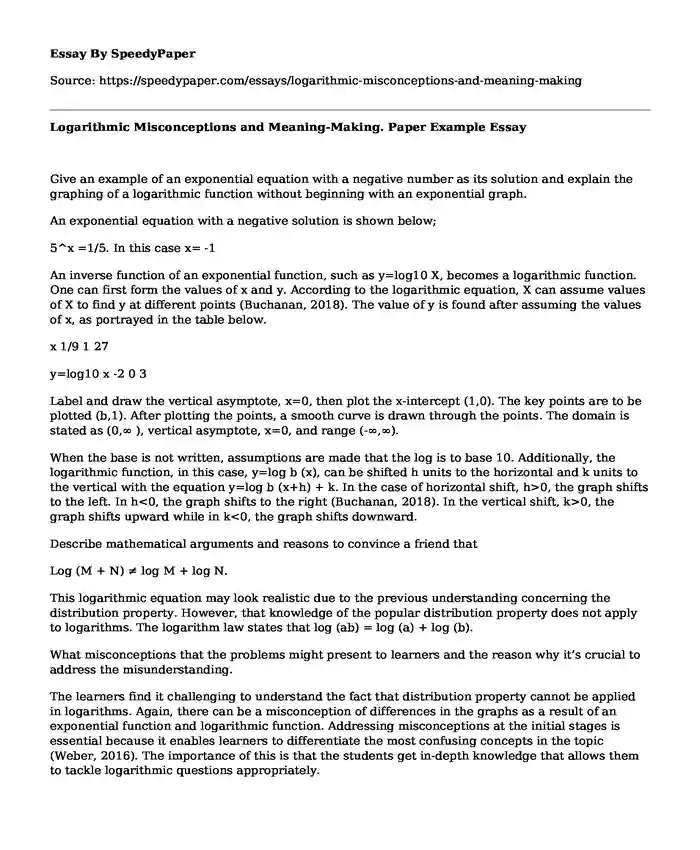
| Essay type: | Quantitative research papers |
| Categories: | Knowledge Mathematics |
| Pages: | 2 |
| Wordcount: | 521 words |
Give an example of an exponential equation with a negative number as its solution and explain the graphing of a logarithmic function without beginning with an exponential graph.
An exponential equation with a negative solution is shown below;
5^x =1/5. In this case x= -1
An inverse function of an exponential function, such as y=log10 X, becomes a logarithmic function. One can first form the values of x and y. According to the logarithmic equation, X can assume values of X to find y at different points (Buchanan, 2018). The value of y is found after assuming the values of x, as portrayed in the table below.
x 1/9 1 27
y=log10 x -2 0 3
Label and draw the vertical asymptote, x=0, then plot the x-intercept (1,0). The key points are to be plotted (b,1). After plotting the points, a smooth curve is drawn through the points. The domain is stated as (0,∞ ), vertical asymptote, x=0, and range (-∞,∞).
When the base is not written, assumptions are made that the log is to base 10. Additionally, the logarithmic function, in this case, y=log b (x), can be shifted h units to the horizontal and k units to the vertical with the equation y=log b (x+h) + k. In the case of horizontal shift, h>0, the graph shifts to the left. In h<0, the graph shifts to the right (Buchanan, 2018). In the vertical shift, k>0, the graph shifts upward while in k<0, the graph shifts downward.
Describe mathematical arguments and reasons to convince a friend that
Log (M + N) ≠ log M + log N.
This logarithmic equation may look realistic due to the previous understanding concerning the distribution property. However, that knowledge of the popular distribution property does not apply to logarithms. The logarithm law states that log (ab) = log (a) + log (b).
What misconceptions that the problems might present to learners and the reason why it’s crucial to address the misunderstanding.
The learners find it challenging to understand the fact that distribution property cannot be applied in logarithms. Again, there can be a misconception of differences in the graphs as a result of an exponential function and logarithmic function. Addressing misconceptions at the initial stages is essential because it enables learners to differentiate the most confusing concepts in the topic (Weber, 2016). The importance of this is that the students get in-depth knowledge that allows them to tackle logarithmic questions appropriately.
How to answer a learner that sees solving of this problem as useless
I will first ensure that I explain the importance and applicability of the concepts in the daily practical areas. I will also ensure that the student understands the basic mathematics vocabularies and concepts concerning logarithms. This is core since it enhances that student’s ability to reason. According to Weber (2016), the capability enables the creation of proof, definitions, and theorems that help in the analysis of several complex systems and concerns in many practical situations.
References
Buchanan, J. R. (2018). Exponential and Logarithmic Functions.
Weber, C. (2016). Making logarithms accessible–operational and structural basic models for logarithms. Journal für Mathematik-Didaktik, 37(1), 69-98. https://link.springer.com/article/10.1007/s13138-016-0104-6
Cite this page
Logarithmic Misconceptions and Meaning-Making. Paper Example. (2023, Aug 20). Retrieved from https://speedypaper.com/essays/logarithmic-misconceptions-and-meaning-making
Request Removal
If you are the original author of this essay and no longer wish to have it published on the SpeedyPaper website, please click below to request its removal:
- Free Essay: Challenge in My Academic Life
- Free Essay: Critical Thinking Reflection on the Article about Second Language Acquisition
- Essay Example on Biotic and Abiotic Factors in an Ecosystem
- Essay Sample on Prevention Techniques for Musculoskeletal Disorders
- Paper Example - Development and Advantages of Geared Turbofan Engine
- Free Paper Sample on Supporting At-Risk Students: Strategies for Success in Education
- Free Paper Sample on Transport Industry
Popular categories




